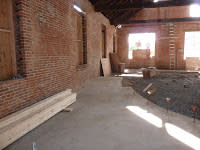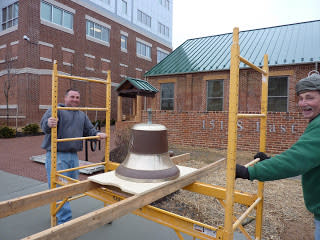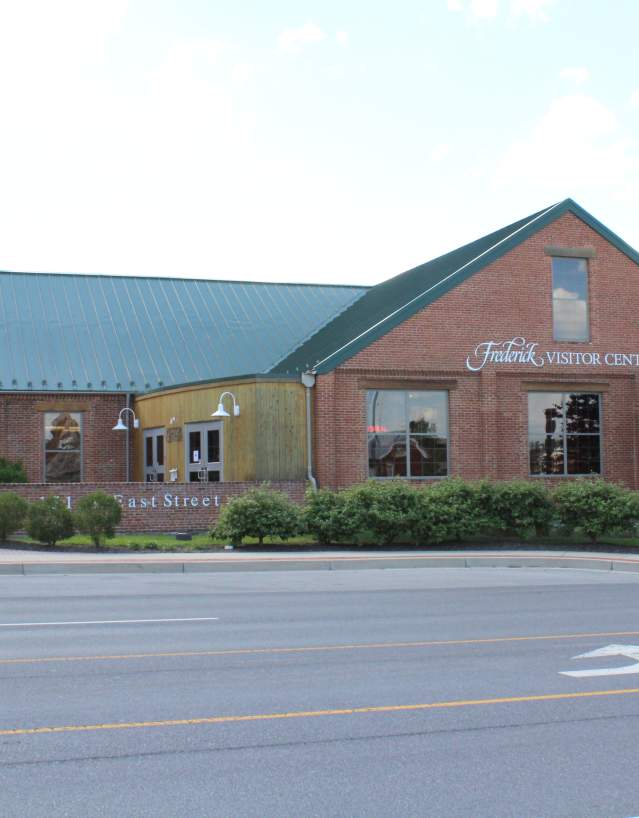History of the Frederick Visitor Center
After thirty years of operating the Visitor Center out of a shared building on Church Street, it was determined in 2005 that future visitors would be better served at a new location. Visit Frederick got to work on the massive undertaking of selecting a site, renovating a historic building, and planning the best possible welcome a Frederick visitor could be given.
Site Selection
Road changes that were getting underway suggested that arriving visitors would be best assisted at a center located along the extension of S. East Street in Frederick to a new I-70 interchange, creating a new gateway to Downtown Frederick at a location central to the network of highways to other destinations in the county.
Preliminary analysis indicated that the preferred location would be along East Street between E. South Street and E. Patrick Street. A new and larger Center could provide amenities not currently available, ranging from simply having more adequate restroom facilities to exhibits and orientation film viewing areas. The center would ideally also house the Visit Frederick offices, with a combined floor area of 6,000 to 6,500 square feet for the visitor service area and offices. In late 2005, Visit Frederick identified and purchased a circa-1899 industrial warehouse to be converted into a new visitor center, along the new "gateway" and within the corridor through Frederick. The project was scheduled for completion in early 2011.
The warehouse was a brick structure on the site of the Frederick Spoke Factory. At the end of the 19th century, just as the spoke manufacturing facility was ceasing operation, the Monocacy Valley Canning Company was being established on the property. For most of its existence, the structure served as a warehouse for the packing company, being accessed by Commerce Street in Frederick and by the B & O Railroad. Today, the structure fronts on the extension of East Street in Frederick linking downtown Frederick, including the MARC commuter rail station across East Street from the project site, to the new interchange at I-70/US 40 just south of the Frederick Towne Historic District. The site is on the section of South East Street that serves as a segment of the eastbound route of the Historic National Road (HNR), designated by the Federal Highway Administration as an All American Road in the National Scenic Byways program. This portion of South East Street connects the eastbound HNR byway, which follows South Street in Frederick parallel to the downtown portion of Patrick Street (which carries HNR traffic one-way westbound), back with East Patrick Street at the point where two-way traffic resumes at the eastern edge of the Frederick Towne Historic District.
The site capitalizes on Frederick's location at the hub of a network of highways that fan out like the spokes of a wheel, including the other National Scenic Byway that passes through Frederick - the Catoctin Mountain Highway (US15), which is part of a larger heritage corridor dubbed the Journey Through Hallowed Ground extending from Gettysburg, PA to Charlottesville, VA; and the Old Main Streets State Scenic Byway. Through these byways the center is linked to the C & O Canal Route, the Catoctin Mountain Loop, and the Atlantic to Appalachians State Scenic Byways.
Through these routes, access is provided to a great range of historic, cultural and natural resources, including State and National parks, battlefields, and more. Two of Maryland’s Civil War Trails, the Antietam Campaign – Lee Invades Maryland and Gettysburg – Invasion & Retreat (Union Advance) driving tours pass through Downtown Frederick and connect the area of the project site with battlefields, museums and other heritage area attractions throughout Frederick, Carroll and Washington counties as well as sites in the Montgomery Heritage Area. Visitors to the center will be able to obtain information about these Trails and sites, whether they intend to follow the Antietam Campaign Trail west into Washington County, or follow the Union advance route during the Gettysburg Campaign northeast into Carroll County. The project site is central to the three-county Heart of the Civil War Maryland Heritage Area (and well positioned to serve the four-state Journey Through Hallowed Ground National Heritage Area). The center will also provide information related to nearby Maryland Main Street program communities of Brunswick, Middletown, Mount Airy, Thurmont and Downtown Frederick; the Monocacy River Water Trails that are part of the Chesapeake Bay Gateways Network; the State-designated Arts & Entertainment District in Frederick; and regional parks and attractions.
The project would provide interpretation relevant to the industrial heritage of the site and historic transportation networks. For example, the historic use of the site marked the point where, for decades, local agricultural produce was brought in by wagon along the National Road, packed and shipped out by railroad or truck. Adjacent canneries, tanneries, a stockyard, coal yards, shutter fastener manufacturing, and the Frederick Brick Works made up this industrial neighborhood just south of the Historic National Road along Carroll Creek and the B & O Railroad. The project site’s 19th-century heritage as home of a spoke factory, coupled with Frederick’s location as the hub from which regional Scenic Byways and other heritage tourism routes emerge like spokes on a wheel, inspired the design and organizational framework for the proposed informational exhibits and displays that will be the focal point of the project.
Construction


Most of the building's windows had been bricked up at some point during the 20th century, as shown in the "before" picture. Masons worked to reopen the window openings, and also made necessary repairs and cleaned up the old brick walls. They also closed in some openings that were added during the life of the building, such as the metal roll-up door on the Commerce Street side (which turned out to be pretty handy for allowing trucks with gravel and concrete access to the interior).
As shown in the second picture, the last of the infill brick is being removed from the windows facing East St. from the exhibit area. Portions of the interior of the building will feature exposed brick walls. A slight ramp seen in the foreground will lead from the front of the theater up into the exhibit area, along the north wall of the building.

Originally, a slate roof sheltered the building. The most recent roof before the renovation was metal. The metal roof, rafters and purlins were removed. Structural Insulated Panels (SIP's) were installed across the original heavy timber trusses providing the new roof structure and adding energy efficiency to the building. The SIP panels were covered by a new standing seam metal roof.

In March 2011, the Frederick County History Bell arrived at its permanent home, to be rung on April 2, five years to the day since it was cast as part of Bell & History Day. For many years, the bell was also rung annually to mark the beginning of Bell & History Day - the beginning of the new museum season.
Grand Opening
On Saturday morning April 2, 2011, a ribbon cutting ceremony marked the Grand Opening of the new Frederick Visitor Center at 151 S. East St. in Frederick. Remarks were made by Frederick Mayor Randy McClement, County Commissioner Paul Smith, and Senator David Brinkley. Chamber of Commerce President & CEO Ric Adams presented additional proclamations offering congratulations on the event, such as the one from MD Governor Martin O'Malley that Adams presents to Tourism Council Executive Director John Fieseler. Tourism Board members, staff and supporters then cut the ribbon and the center opened for visitors 7 days/week from 9am to 5:30pm.
The Frederick County History Bell was dedicated and rung for the first time in its permanent home in front of the Visitor Center as part of the Grand Opening of the facility. Mrs. Frances Randall rang it first, representing the Randall family whose generosity provided the casting of the bell exactly five years earlier to mark the return of the annual Bell & History Days museum season opening in Frederick County. Many others then took turns ringing the bell for a total of three minutes.
The multi-screen award-winning orientation video A Turn of the Wheels featuring sites and scenes in Frederick County began showing in the theater of the new Frederick Visitor Center. The film shows continuously during Visitor Center seven days a week. The film narration is captioned on one of the screens, and there are also assisted listening devices available.

